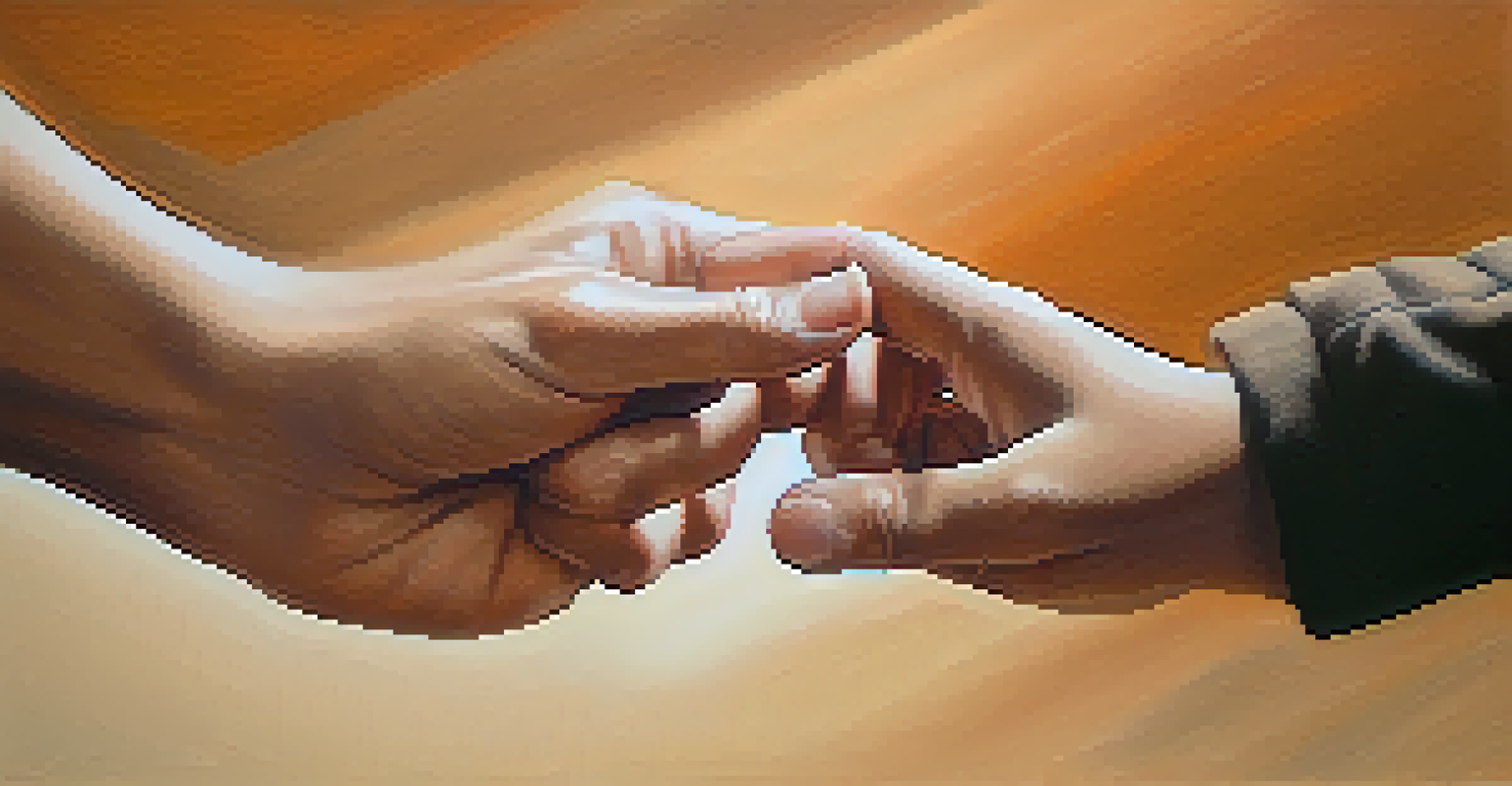De-escalation Strategies: Insights from Martial Arts Techniques

Understanding De-escalation: What It Means in Practice
De-escalation refers to the process of reducing tension in a conflict. It’s about finding ways to defuse potentially volatile situations before they escalate into aggression or violence. Much like a martial artist seeks to control an opponent's energy rather than meet it with force, de-escalation involves redirecting negative emotions into a calmer state.
The greatest weapon against stress is our ability to choose one thought over another.
In practice, this means using techniques that promote understanding and empathy. For instance, when someone is upset, instead of matching their intensity, you might lower your voice and approach them with a calm demeanor. This shift can help create a safe space for dialogue, making it easier to resolve conflicts peacefully.
Ultimately, the goal of de-escalation is to foster a sense of safety and trust. Just as in martial arts, where the aim is to protect oneself and others, effective de-escalation strategies prioritize the well-being of all parties involved.
The Importance of Body Language in De-escalation
Body language plays a crucial role in communication, especially during tense moments. In martial arts, practitioners learn to read their opponent's movements and intentions; similarly, being aware of one's own body language can significantly impact a de-escalation scenario. Open and relaxed postures can signal non-threat, while tense gestures may escalate conflict.

For example, crossing your arms can be perceived as defensive or closed-off, which may heighten someone's anxiety. In contrast, maintaining eye contact and nodding can convey understanding and engagement, helping to ease the situation. This awareness allows you to adapt your approach in real-time, much like a martial artist adjusts their stance based on their opponent's actions.
De-escalation Reduces Conflict Tension
De-escalation involves using techniques to lower tension and foster understanding in potentially volatile situations.
By mastering body language, individuals can create a more conducive environment for resolution. Just as in martial arts, where physical movements can dictate the flow of a match, non-verbal cues can steer the direction of a conversation.
Active Listening: A Key Component of De-escalation
Active listening is an essential skill in de-escalation, mirroring the focus a martial artist has on their opponent. It involves fully concentrating on what the other person is saying, rather than just waiting for your turn to speak. This not only shows respect but also allows you to understand their perspective, which is crucial for finding common ground.
The single biggest problem in communication is the illusion that it has taken place.
For instance, when someone expresses frustration, paraphrasing their concerns can demonstrate that you are engaged. Saying something like, 'It sounds like you're really upset about this situation,' can help validate their feelings. This technique mirrors the way martial artists often reflect on their opponent’s movements before making a tactical decision.
By actively listening, you create an atmosphere of trust, which is vital for effective de-escalation. Just as a martial artist remains calm and focused, being present and responsive can transform a heated exchange into a constructive conversation.
Verbal Techniques: Choosing Words Wisely
The words we choose can either soothe or provoke a situation, making verbal techniques essential in de-escalation. Much like martial artists use precise language to communicate during training, choosing words carefully in a conflict can influence the emotional climate. Phrases that promote collaboration are more effective than those that may seem confrontational.
For example, instead of saying, 'You need to stop yelling,' try framing it as, 'I’d appreciate it if we could discuss this calmly.' This subtle shift not only reduces defensiveness but also opens the door for dialogue. It reflects the martial arts principle of using an opponent's energy to your advantage, rather than fighting against it.
Body Language Influences Outcomes
Awareness of body language can significantly impact de-escalation efforts, as open and relaxed postures promote a non-threatening environment.
By mastering verbal techniques, individuals can steer conversations toward resolution rather than escalation. Just as martial arts involve strategy and precision, effective communication requires thoughtfulness and intention.
Empathy: Understanding the Other Person's Perspective
Empathy is a powerful tool in de-escalation, akin to the understanding a martial artist develops about their opponent's mindset. By putting yourself in someone else's shoes, you can better grasp their emotions and reactions. This awareness can help you respond in a way that acknowledges their feelings, making it easier to resolve conflicts.
For instance, acknowledging that someone may be stressed due to a personal issue can shift the focus from blame to understanding. Just as a martial artist studies their opponent's techniques to anticipate their moves, empathizing with others allows you to predict their responses and adjust accordingly.
Ultimately, empathy fosters connection, reducing the likelihood of escalation. By embracing this principle, you not only enhance your de-escalation skills but also cultivate stronger relationships built on trust and respect.
Setting Boundaries: A Critical Aspect of De-escalation
Setting boundaries is essential in de-escalation, much like understanding one's own limits in martial arts. Boundaries help maintain respect and safety for all parties involved. Clear expectations about acceptable behavior can provide a framework for discussions, preventing situations from spiraling out of control.
For example, calmly stating, 'I’m open to discussing this, but I can’t engage if we’re yelling,' establishes a boundary that promotes a respectful dialogue. This mirrors the martial arts principle of knowing when to engage and when to retreat, ensuring that interactions remain constructive.
Empathy Enhances Conflict Resolution
Empathy allows individuals to understand different perspectives, making it easier to respond constructively and reduce conflict.
By setting boundaries, you create a structured environment where de-escalation is possible. Just as martial artists learn to respect their own limits, individuals must also honor their emotional and physical boundaries during conflicts.
Practicing Patience: The Art of Timing in De-escalation
Patience is a vital skill in both martial arts and de-escalation. Just as a martial artist waits for the right moment to strike, knowing when to pause during a conflict can make all the difference. Sometimes, allowing a moment of silence can defuse tension and provide clarity for all involved.
For instance, if emotions are running high, taking a deep breath or suggesting a short break can help everyone regroup. This pause is similar to how martial artists take a moment to assess their opponent’s moves before responding. It can prevent hasty reactions that might escalate the situation.

By practicing patience, you empower yourself to respond thoughtfully rather than react impulsively. Just as in martial arts, where timing is key, mastering the art of waiting can be transformative in de-escalation scenarios.